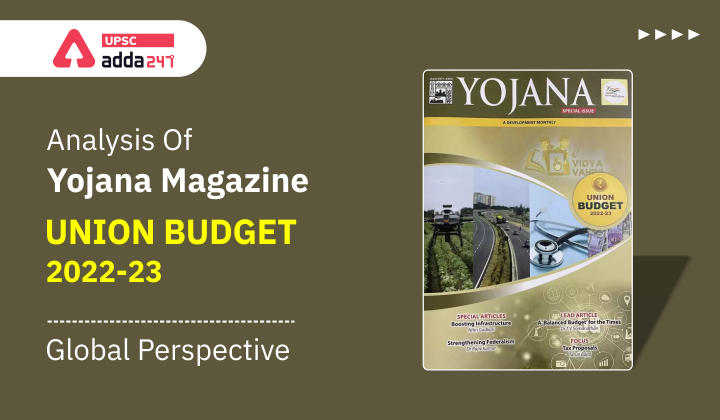Table of Contents
Analysis Of Yojana Magazine: ”Union Budget 2022-23 – Global Perspective”
Relevance
GS 3: Growth & Development, Planning, Government Budgeting, Inclusive Growth
Introduction
- India is the world’s sixth-largest economy. It also often boasts of being the fastest-growing large economy.
- However, given its per capita income level of about USD 2000 a year, it is still considered a low middle-income country.
- The measures announced in the Budget and the direction in which they steer the nation should help India become much more competitive globally.
- The Indian economy is poised to grow at the quickest pace among the league of large nations on the back of various initiatives taken by the government in Budget 2022-23.
How Indian Economy is doing?
- India’s economic growth in the current year is estimated to be 9.2 per cent, the highest among all large economies.
- The overall, sharp rebound and recovery of the economy from the adverse effects of the pandemic is reflective of our country’s strong resilience.
- India recently achieved its ambitious target of crossing $400 billion exports in the current financial year 2021-22. With this, India has achieved a key milestone in its journey towards becoming ‘aatmanirbhar’. This is the first time ever that exports have crossed the $400 billion mark. The previous best was $331.02 billion which was achieved in 2018-19.
Key Points
- India’s nominal gross domestic product (GDP) at current prices is estimated to be at Rs. 232.15 trillion (US$ 3.12 trillion) in FY2021-22.
- India is the third-largest unicorn base in the world with over 83 unicorns collectively valued at US$ 277.77 billion, as per the Economic Survey.
- By 2025, India is expected to have 100 unicorns, which will create ~1.1 million direct jobs according to the Nasscom-Zinnov report ‘Indian Tech Start-up’.
- India needs to increase its rate of employment growth and create 90 million non-farm jobs between 2023 and 2030s, for productivity and economic growth according to McKinsey Global Institute.
- The net employment rate needs to grow by 1.5% per year from 2023 to 2030 to achieve 8-8.5% GDP growth between 2023 and 2030.
- According to data from the Department of Economic Affairs, as of January 28, 2022, foreign exchange reserves in India reached the US$ 634.287 billion mark.
Government Initiatives
The Government of India has taken several initiatives to improve the economic condition of the country. Some of these are:
- The budget had four priorities PM GatiShakti, Inclusive Development, Productivity Enhancement and Investment and Financing of Investments.
- In the Union Budget 2022-23, effective capital expenditure is expected to increase by 27% at Rs. 10.68 lakh crore (US$ 142.93 billion) to boost the economy. This will be 4.1% of the total Gross Domestic Production (GDP).
- Under PM GatiShakti Master Plan the National Highway Network will develop 25,000 km of new highways network which will be worth Rs. 20,000 crore (US$ 2.67 billion)
- Increased government expenditure is expected to attract private investments, with a production-linked incentive scheme providing excellent opportunities. Consistently proactive, graded, and measured policy support is anticipated to boost the Indian economy.
- productivity linked incentive (PLI) schemes to be extended to 14 sectors for achieving the mission of Atma Nirbhar Bharat and create 60 lakh (6 million) and additional production of Rs. 30 lakh crore (US$ 401.49 billion) in the next 5 years.
- A scheme for design-led manufacturing in 5G will be launched as part of the PLI scheme.
- Key reforms include rationalization of adjusted gross revenue, rationalization of bank guarantees (BGs), and encouragement to spectrum sharing.
- The budgetary planned changes to the customs tax regime may appear small at first glance, but a closer examination of products reveals an increasing convergence between India’s industrial and trade policies, as well as a focus on making India a prominent player in Global Value Chains (GVCs).
- The government has allocated Rs. 44,720 crore (US$ 5.98 billion) to Bharat Sanchar Nigam Limited (BSNL) for capital investments in the 4G spectrum.
- Govt. allocated Rs. 650 crore (US$ 86.69 million) for Deep Ocean mission that seeks to explore vast marine living and non-living resources.
- Department of Space (DoS) has got Rs. 13,700 crore (US$ 1.83 billion) in 2022-23 for several key space missions like Gaganyaan, Chandrayaan-3, and Aditya L-1 (sun).
- Reserve Bank of India (RBI) will issue Digital Rupee using blockchain and other technologies.
- Railway got an investment of Rs. 2.38 lakh crore (US$ 31.88 billion) and over 400 new high-speed trains were announced. The concept of “One Station, One Product” was also introduced.
- To boost competitiveness Budget 2022 has announced to reform the 16-year-old Special Economic Zone (SEZ) act to enhance competitiveness this will be done to make it compatible with the World Trade Organisation (WTO).
- The Government of India is going to increase public health spending to 2.5% of the GDP by 2025.
Conclusion
India has emerged as the fastest-growing major economy in the world and is expected to be one of the top three economic powers in the world over the next 10-15 years, backed by its robust democracy and strong partnerships.



 TSPSC Group 1 Question Paper 2024, Downl...
TSPSC Group 1 Question Paper 2024, Downl...
 TSPSC Group 1 Answer key 2024 Out, Downl...
TSPSC Group 1 Answer key 2024 Out, Downl...
 UPSC Prelims 2024 Question Paper, Downlo...
UPSC Prelims 2024 Question Paper, Downlo...
